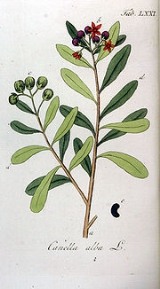
Canellaceae
Encyclopedia
The Canellaceae are a family of flowering plant
s. The family has sixteen species
in six genera
. The species are highly aromatic evergreen
plants, mostly trees and rarely shrubs, which produce essential oil
s. Families Cannelaceae and Winteraceae
form order Canellales
.
The family is found tropical climate regions in the Afrotropic
and Neotropic
ecozones, including South America
, the West Indies and Florida
, East Africa
, and Madagascar
.
The APG II system
(2003) assigns it to the order Canellales
in the clade magnoliids. This represents a change from the 1998 APG system
, which left the family unplaced as to order and merely listed it among the basal lineages of the angiosperms.
Flowering plant
The flowering plants , also known as Angiospermae or Magnoliophyta, are the most diverse group of land plants. Angiosperms are seed-producing plants like the gymnosperms and can be distinguished from the gymnosperms by a series of synapomorphies...
s. The family has sixteen species
Species
In biology, a species is one of the basic units of biological classification and a taxonomic rank. A species is often defined as a group of organisms capable of interbreeding and producing fertile offspring. While in many cases this definition is adequate, more precise or differing measures are...
in six genera
Genus
In biology, a genus is a low-level taxonomic rank used in the biological classification of living and fossil organisms, which is an example of definition by genus and differentia...
. The species are highly aromatic evergreen
Evergreen
In botany, an evergreen plant is a plant that has leaves in all seasons. This contrasts with deciduous plants, which completely lose their foliage during the winter or dry season.There are many different kinds of evergreen plants, both trees and shrubs...
plants, mostly trees and rarely shrubs, which produce essential oil
Essential oil
An essential oil is a concentrated hydrophobic liquid containing volatile aroma compounds from plants. Essential oils are also known as volatile oils, ethereal oils or aetherolea, or simply as the "oil of" the plant from which they were extracted, such as oil of clove...
s. Families Cannelaceae and Winteraceae
Winteraceae
The Winteraceae are a family of flowering plants. The family includes 120 species of trees and shrubs in 9 genera.The Winteraceae are a mostly southern-hemisphere family associated with the Antarctic flora, found in tropical to temperate climate regions of Malesia, Oceania, eastern Australia, New...
form order Canellales
Canellales
Canellales is the botanical name for an order of flowering plants, one of the four orders of the magnoliids. It is defined to contain two families: Canellaceae and Winteraceae, which comprise 136 species of fragrant trees and shrubs...
.
The family is found tropical climate regions in the Afrotropic
Afrotropic
The Afrotropic is one of the Earth's eight ecozones. It includes Africa south of the Sahara Desert, the southern and eastern fringes of the Arabian Peninsula, the island of Madagascar, southern Iran and extreme southwestern Pakistan, and the islands of the western Indian Ocean. It was formerly...
and Neotropic
Neotropic
In biogeography, the Neotropic or Neotropical zone is one of the eight terrestrial ecozones. This ecozone includes South and Central America, the Mexican lowlands, the Caribbean islands, and southern Florida, because these regions share a large number of plant and animal groups.It is sometimes used...
ecozones, including South America
South America
South America is a continent situated in the Western Hemisphere, mostly in the Southern Hemisphere, with a relatively small portion in the Northern Hemisphere. The continent is also considered a subcontinent of the Americas. It is bordered on the west by the Pacific Ocean and on the north and east...
, the West Indies and Florida
Florida
Florida is a state in the southeastern United States, located on the nation's Atlantic and Gulf coasts. It is bordered to the west by the Gulf of Mexico, to the north by Alabama and Georgia and to the east by the Atlantic Ocean. With a population of 18,801,310 as measured by the 2010 census, it...
, East Africa
East Africa
East Africa or Eastern Africa is the easterly region of the African continent, variably defined by geography or geopolitics. In the UN scheme of geographic regions, 19 territories constitute Eastern Africa:...
, and Madagascar
Madagascar
The Republic of Madagascar is an island country located in the Indian Ocean off the southeastern coast of Africa...
.
The APG II system
APG II system
The APG II system of plant classification is the second, now obsolete, version of a modern, mostly molecular-based, system of plant taxonomy that was published in April 2003 by the Angiosperm Phylogeny Group. It was a revision of the first APG system, published in 1998, and was superseded in 2009...
(2003) assigns it to the order Canellales
Canellales
Canellales is the botanical name for an order of flowering plants, one of the four orders of the magnoliids. It is defined to contain two families: Canellaceae and Winteraceae, which comprise 136 species of fragrant trees and shrubs...
in the clade magnoliids. This represents a change from the 1998 APG system
APG system
The APG system of plant classification is the first, now obsolete, version of a modern, mostly molecular-based, system of plant taxonomy that was published in 1998 by the Angiosperm Phylogeny Group. It was superseded in 2003 by a revision, the APG II system, and then in 2009 by a further...
, which left the family unplaced as to order and merely listed it among the basal lineages of the angiosperms.

